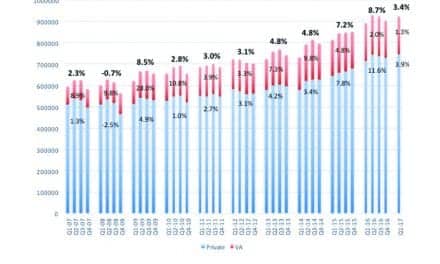Automatic and adaptive acoustic feedback reduction is one of the most beneficial algorithms offered in modern hearing aids. This article describes a new transient frequency shifting technology, Siemens FeedbackStopper, which has been shown to provide an additional 7 dB of added stable gain, making maximum added stable gain as high as 25 dB.
Acoustic feedback is one of the most negative aspects associated with hearing instruments. In many cases, the annoyance, frustrations, and embarrassment caused by feedback may even outweigh an individual’s otherwise perceived benefit of amplification.



This article was submitted to HR by Josef Chalupper, PhD, director of audiology at Siemens Audiologische Technik (SAT), GmbH, Erlangen, Germany; Thomas A. Powers, PhD, vice president of audiology and compliance at Siemens Hearing Instruments, Piscataway, NJ; and Andre Steinbuss, PhD, head of audiological research and product development at SAT. Correspondence can be addressed to HR at [email protected] or Josef Chalupper, PhD, at .
Acoustic feedback also can indirectly reduce patient benefit with amplification. They may choose to use less-than-optimal gain to avoid the likelihood of feedback, use the hearing aids only for situations known to be “feedback free,” or in extreme cases, simply stop using the hearing instruments. Acoustic feedback even contributes to the “hearing aid effect,” as potential users of amplification view acoustic feedback as part of the negative stigma associated with hearing loss.1
Minimizing feedback through effective feedback reduction algorithms also allows for more flexibility in selecting hearing aid style, as the tightness of the fitting is less critical. With a sophisticated automatic feedback reduction system, the occlusion effect can be eliminated and sound quality can be improved in cases where it otherwise would not have been possible.
For this reason, effective feedback solutions have been the driving factor in the success of today’s open-canal technology. When all these factors are combined, it is easy to understand why many experts consider automatic-adaptive feedback reduction the most beneficial development in hearing aid technology over the past decade.
Acoustic feedback occurs when amplified sound from the receiver leaks out of the ear canal (eg, around the earmold, through a vent, etc), is picked up by the microphone, and in turn amplified again. The route the amplified signal travels back to the microphone is called the feedback path. The goal, therefore, is to break this feedback path. This article introduces a new method to control feedback, the Siemens FeedbackStopper, a feature that is now included in all Siemens BestSound technology.
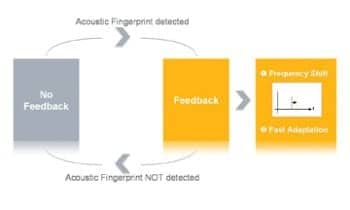
FIGURE 1. How the FeedbackStopper algorithm combines phase cancellation, frequency shifting, and Acoustic Fingerprint Technology (AFT).
Attempts to Reduce Feedback
Feedback suppression is, and has always been, an important topic for the hearing instrument industry. Generally, two methods have been used to counteract feedback: gain reduction (notch filters) and phase cancellation.
Gain reduction and notch filters—the approach used in most hearing aids until 2004—reduce gain in the frequency region where feedback occurs. While this approach can be successful in eliminating feedback, it also reduces gain for target signals like speech, resulting in reduced speech intelligibility.
Phase cancellation systems, on the other hand, are capable of suppressing feedback without degrading the audibility of speech, and therefore this type of feedback reduction is currently considered “the industry standard.”
While most currently available feedback management systems are able to account for individual ear and fitting differences, and counteract the static feedback path, the challenge lies in rapidly changing feedback paths. Even for the same person, no matter how well an earmold or in-the-ear hearing instrument fits in the canal, as the user goes about daily life, the feedback path changes when talking or chewing, when leaning a head back against the couch, or when hugging a loved one.
Changes in the feedback path, such as these, occur very quickly. In order to eliminate feedback in these situations before it becomes disturbing to the user, it is essential that the feedback canceller acts within milliseconds. A potential downside, however, is that fast-acting feedback cancellation systems often mistake tonal stimuli in the environment—such as music—for feedback, and thereby can create artifacts and distortions.
In summary, a good feedback cancellation must fulfill three requirements:
- Effective feedback suppression without affecting target signals like speech;
- Fast adaption to changing environments; and
- Robustness against artifacts.
Phase cancellation systems, the industry standard, are very effective for reducing feedback. However, several different design features should be considered. For this reason, we have seen a constant advancement of phase cancellation systems over the past several years at Siemens, including:
2004: First fully adaptive phase cancellation algorithm without the need of initialization.
2006: Adaptive feedback cancellation with adaptation speed control,providing a faster feedback cancellation with fewer artifacts.
2008: 3rd-generation algorithm using Acoustic Fingerprint Technology (AFT) to mark the outgoing signal. This marking helps improve the accuracy of feedback detection so the cancellation can be conducted faster—resulting in fewer artifacts and more feedback stability.
2010: 4th-generation phase cancellation system is introduced, called FeedbackStopper.
The 4th-Generation Feedback System
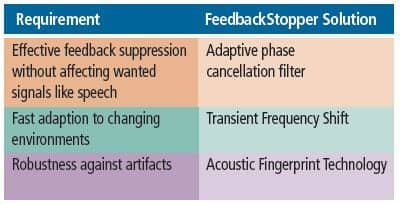
TABLE 1. Requirements and appropriate solutions for feedback suppression with the hearing instrument.
Siemens FeedbackStopper is an adaptive phase cancellation system combined with Acoustic Fingerprint Technology and transient frequency shift. The adaptive phase cancellation filter effectively cancels feedback by continuously estimating the feedback path and generating a corresponding out-of-phase signal. Thus, feedback is suppressed without reducing gain for external signals like speech, music, and environmental sounds.
An extremely fast adaptation to changing feedback paths is achieved by using transient frequency shifting: briefly shifting the frequency by 25 Hz breaks the feedback loop and therefore helps suppress feedback. But, even more importantly, the frequency shift assists in avoiding artifacts. This is because the adaptive filter is more likely to generate artifacts if external signals are similar to the feedback signal. Shifting the frequency of the feedback signal makes it less similar to the external signal so that the adaptive filter can react extremely quickly without generating artifacts. This small frequency shift may be perceived by some listeners as a slight “roughness” in sound quality; however, the brief roughness is much less audible or annoying than the whistling of feedback.
Absolute freedom from artifacts can be achieved only if the adaptation is stopped and if the frequency shifting is switched off. To maximize listening comfort, therefore, FeedbackStopper completely halts adaptation and frequency shifting whenever there is no feedback risk. To distinguish between feedback situations and non-feedback situations, FeedbackStopper employs the Siemens patented Acoustic Fingerprint Technology (AFT). Similar technologies are used in audio coding and referred to as “digital watermarking.” With AFT, the amplified signal that leaves the hearing instrument receiver is slightly phase modulated and this “tag” or “fingerprint” is used to identify signals that have already been amplified by the hearing aid (ie, feedback potential).
It has been demonstrated in psychoacoustic experiments that this phase modulation tag is inaudible to the human ear. It can, however, be identified by a technical modulation detector and used as a critical piece of information that tells the FeedbackStopper when to activate frequency shift and apptation.
Figure 1 illustrates how the new FeedbackStopper works. Once the acoustic fingerprint is detected (eg, feedback is likely to occur) in a particular acoustic situation, FeedbackStopper briefly shifts the entire output of the amplifier by 25 Hz. This frequency shift breaks up the feedback loop and allows adapting the phase cancellation filter very quickly—usually before feedback results in audible whistling. As soon as the adaptation is finished, feedback is suppressed and thus the modulation tag is no longer detected in the incoming signal. Now, the FeedbackStopper switches off frequency shifting and completely freezes the adaptation in order to avoid artifacts. Table 1 summarizes how these three technologies are used as part of the overall feedback reduction strategy.
Clinical Research with FeedbackStopper
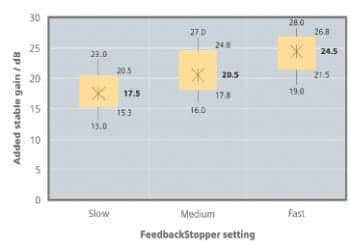
FIGURE 2. Added stable gain provided by FeedbackStopper for slow, medium, and fast settings. Overall values are based on comparison to maximum gain that could be obtained with the FeedbackStopper in the “off” setting.
To examine the effectiveness of this new technology, two clinical studies were conducted. In the first, the benefit of the frequency shifting technology was evaluated. In the second study, the Siemens FeedbackStopper technology was compared to the feedback suppression systems of other major manufacturers.
Study #1: Frequency shift technology. In this research, the FeedbackStopper algorithm was tested in listening situations that replicated real-world conditions (see Chalupper2 for review). A total of 12 subjects with moderately downward-sloping hearing loss listened to babble noise presented at 50 dBSPL while moving their heads, chewing, and talking. Added stable gain provided by FeedbackStopper with and without frequency shift was measured. To determine baseline, with the FeedbackStopper in the “off” setting, the subjects were fitted to the NAL-NL1 prescriptive method, and then overall gain was increased until feedback was present.
The results in Figure 2 show significant (p < 0.01) improvements of 7 dB for the FeedbackStopper with frequency shifting activated (setting “fast”) compared to a setting with the same phase cancellation setting but without frequency shifting. The medium setting also employs frequency shifting, but with a slower adaptation speed of the phase canceller. On average, compared to the original NAL-NL1 fitting, added stable gain of 24.5 dB was achieved with the FeedbackStopper in “fast.” This clearly equals or exceeds the needed margin for variations of the feedback path in real-world listening for the majority of hearing instrument wearers.
Study #2: FeedbackStopper compared to other leading products. There are many different reports available regarding the effectiveness of automatic feedback reduction algorithms. Unfortunately, different measurement procedures often are used, and therefore it is difficult to make direct manufacturer-to-manufacturer comparisons. For this reason, it is important that independent researchers conduct unbiased benchmark research, using identical measurement procedures to evaluate all products. Such a study recently was conducted at the auditory research laboratory of Vanderbilt University in Nashville.3
In the initial phase of the study, each of the six worldwide leading manufacturers were requested to provide samples of their premier hearing aid, the device that had the “best” feedback reduction system. Each of these six products was then tested for different settings until the feedback reduction for each product was optimized while still not generating artifacts that were audible to listeners with normal hearing.
The products were fitted to individuals in a totally open-ear canal configuration to create a feedback-prone fitting. The hearing aids were programmed to the NAL-NL1 prescriptive targets for a mild-to-moderate downward sloping hearing loss, verified via probe-microphone measurements.
The experimenter monitored the real-ear gain throughout the measurement. With the feedback reduction algorithm turned off, the gain was then raised across all frequencies until feedback occurred. The feedback algorithm was then turned on, and the gain was again raised until feedback occurred. The measured real-ear gain was used to obtain two key measures: added stable gain (the additional gain obtained when the feedback algorithm was activated) and the most important finding—degree of feedback-free real-ear insertion gain (REIG). The preliminary data reported here reflect averages obtained on the first 10 ears evaluated in this study.
It is important to point out that the research protocol required study participants to talk, walk around, place their hand near their ears, etc—mimicking the activities of a typical hearing aid user. The goal was to determine the maximum gain for real-world wearing conditions. The test results, therefore, might not agree with published results obtained using the KEMAR in an anechoic chamber or human subjects under less realistic conditions (eg, without placing a hand near the ear). The probe mic measurements indicated that some models automatically reduce gain when approaching the feedback margin.
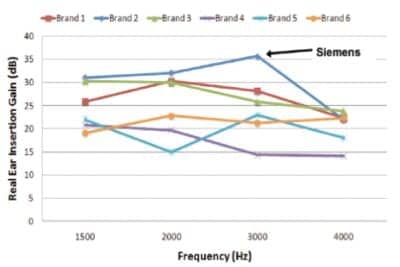
FIGURE 3. Maximum feedback-free real-ear insertion gain for six different openfitted receiver-in-canal hearing instruments.
The added stable gain (ASG) was calculated for the key frequencies of 2000, 3000, and 4000 Hz. The results showed a large ASG difference among the six manufacturers. For example, Siemens and Brand A had the highest mean ASG (13 and 14.5 dB, respectively) whereas Brand D and Brand E had a mean ASG of only 2.3 to 3 dB.
Although ASG findings are commonly used and can be informative, these results do not necessarily identify the “best” feedback system from a clinical standpoint. For example, if the hearing aid is very stable with the feedback algorithm “off,” there is less room for improvement with it “on” (the gain limits will be reached), and the ASG will be smaller as a result. A more informative measure—especially related to the practical fitting of open-canal hearing aids—is the amount of feedback-free real-ear gain that is available when the ear canal is open.
Shown in Figure 3 are the mean REIG findings for the six manufacturers. These values represent the average maximum gain that could be obtained for an open fitting with the feedback algorithm activated. There were significant differences among manufacturers, with the best overall results obtained with Siemens Pure 701. Observe that the difference is as much as 15 to 20 dB between the Siemens product and some of the other products.
This has a major impact on defining the fitting range. Observe that, for the key frequency of 3000 Hz, the Siemens device has a 7 dB advantage over Brand A, its nearest competitor. A gain advantage of this magnitude can extend the fitting range by 15 to 20 dB.
Fine-tuning the System in the Fitting Software
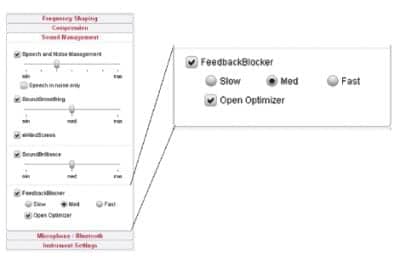
FIGURE 4. Fine-tuning options for the FeedbackStopper.
There are adjustments that can be made in the fitting software to alter the feedback suppression effects. FeedbackStopper has three settings:
- Slow setting. Fast feedback suppression without frequency shift. This setting is optimized for maximum sound quality and should be chosen for individuals who are less prone to feedback and more disturbed by the roughness in sound quality introduced by frequency shift.
- Medium setting. Fast feedback suppression, which features a less sensitive frequency shift activation so that shifting occurs only when absolutely necessary. This is the default setting.
- Fast setting. Fast feedback suppression with a more sensitive frequency shift activation so that the shift occurs more often. This setting should be used for individuals more prone to feedback and not as bothered by occasional roughness in sound quality caused by frequency shift.
Since open-canal fittings are the most challenging for feedback stability, the Open Optimizer featured in Pure and Life instruments further improves the effectiveness of FeedbackStopper. This is achieved by optimizing the parameterization of the signal processing on specific properties of the acoustic feedback path of open-canal fitting. By activating the Open Optimizer, the stable gain of Pure and Life open-canal fittings can be increased by about 4 dB. Hence, for fittings with closed and open domes/tips and vents larger than 2.5 mm, Open Optimizer should be activated in order to achieve maximum feedback stability.
Demonstrating the System to Patients
The FeedbackStop-per can be demonstrated with the hearing instrument either in the patient’s ear or on a model ear. To begin, set the FeedbackStopper to “off,” with the hearing aid at “use gain” (or CONNEXX Fit), then slowly approach the hearing instrument with an open hand. Note the distance between the hand and the hearing instrument when feedback first occurs. Next, set the FeedbackStopper to the Fast setting. Note how much closer the hand can be to the hearing instrument before feedback occurs, indicating that the FeedbackStopper can effectively eliminate feedback even in the most critical situations. If you use real-ear probe-microphone measures, the “before and after” settings can be recorded to provide visual display for patient counseling.
Summary
Acoustic feedback reduction that works automatically and adaptively is one of the most beneficial algorithms offered in modern hearing aids. An effective system can significantly impact hearing aid use, benefit, and satisfaction. The new transient frequency shifting technology has been shown to provide an additional 7 dB of added stable gain, making maximum added stable gain as high as 25 dB.
As we reviewed, independent research compared the Siemens FeedbackStopper to the premier product from five other manufacturers, and assessed the real-ear effectiveness of the feedback reduction algorithms when the hearing aids were used in real-world condition. The results showed large variability among the different products, with the Siemens Pure 701 demonstrating superior performance.
The effectiveness of a feedback algorithm can greatly influence hearing instrument fitting range, and can significantly impact the audibility provided by the instrument. The use of an effective feedback suppression system, therefore, ultimately influences hearing aid benefit and satisfaction.
References
- Cox RM, Alexander GC. Expectations about hearing aids and their relationship to fitting outcome. J Am Acad Audiol. 2000;11:368-382.
- Chalupper J. Advances in automatic feedback suppression. Paper presented at: Annual Convention of the American Academy of Audiology; April 2010; San Diego.
- Ricketts TA. Adults with mild and moderate hearing loss: are they really hearing aid candidates? Paper presented at: International Hearing Aid Research Conference; August 2010; Lake Tahoe, Calif.
Citation for this article:
Chalupper J, Powers TA, Steinbuss A. Combining phase cancellation, frequency shifting, and acoustic fingerprint for improved feedback suppression. Hearing Review. 2011;18(1):24-29.




